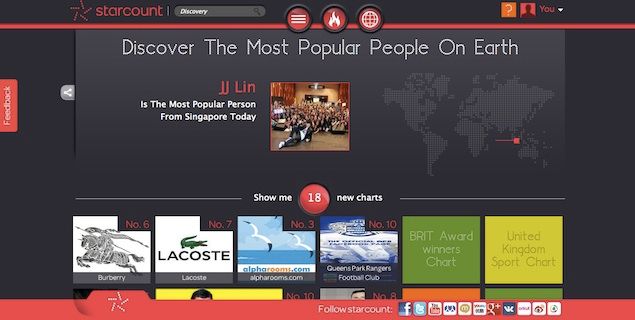A new website, launching at the end of May, will measure the behaviour of 1.5 billion social network users before aggregating the results into popularity charts.
Starcount is affiliated with 11 different social networks worldwide as it measures who and what people are talking about. Users can, in effect, see who the most popular person in the world is at any given moment -albeit according to the social media stratosphere.
Pocket-lint met Starcount’s CEO, Drew Thomson, who told us the way in which trends and topics are measured has changed.
“Social media has become the primary medium for consumption for our generation," said Thomson. "Regular ways of charting (ie, through sales) are no longer accurate as it doesn't actually reflect what’s happening in the market. Social Media is the only real global measurement.”
Thomson may have a point, with illegal downloads, for example, affecting the accuracy of the music singles chart. Starcount’s charts can be broken down into specific categories and regions though all results are aggregated from the 11 affiliated global social networks.
These networks are Facebook, RenRen, Twitter, Tencent Weibo, Sina Weibo, YouTube. YouKu, mixi Vkontakte, Google+ and Orkut. If you haven’t heard of some of these networks, rest assured - they’re a big deal in other countries. Tencent Weibo for example is a Chinese blog that boasts more than 330 million users.
Starcount uses a weighting process to score topics through popularity and engagement, so should David Beckham be selected for the Olympics expect his name to rocket up the charts, before being replaced the next day by Eminem as he releases his latest album.

As well as monitoring trending topics, it’s hoped Starcount users will also use the service to discover new things. For example, a gamer in Scotland could access the worldwide gaming charts and discover a new title that has taken Japan by storm. What's more, if you are someone with a big online social media presence you can monitor your own popularity, though you may want to lower the parameters (this particular journalist is the seventh most popular writer in Bethnal Green. Not really he's actually eleventh).
Of course if statistics are your bag, there’s plenty to get your teeth into, with each subject broken down into specifics relating to each social network, such as the number of YouTube views, number of Facebook fans or Twitter followers.
There’s plenty of scope for marketing companies, too, with Starcount adding new charts accordingly as long as a brand has a social media presence.
“We can build bespoke charts and send them directly to you. These charts will then automatically be updated on a daily basis while you can choose to share the results or keep them to yourselves,” said Thomson.
Starcount hopes to add more social networks to its aggregated feed, “so long as they have credibility and multiple reach”, so expect the results to become even more globalised.
Thomson is keen to point out that Starcount is not trying to replace the likes of Facebook - in fact, just the opposite.
“Starcount is not trying to become a social network. We are celebrating social networks. We hope Starcount creates conversations within social networks by sharing information. We want to get people from all around the world talking to each other.”
Starcount’s website, www.starcount.com goes live on Thursday 31 May.
What do you think of Starcount? Let us know your thoughts.



